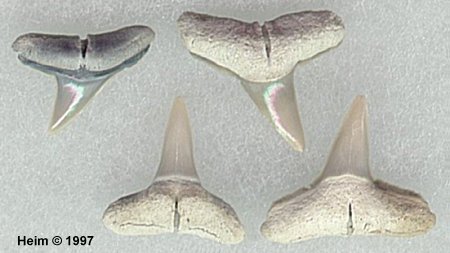|

Usually smaller than the two modern Negaprion species these teeth are uncommon though
not particularly rare finds in the Pungo River formation.
Similar in appearance to teeth of Carcharhinus, they lack serrations on the main
cusp. Instead they possess wavy serrations on the enamaloid root shoulders.
 Purdy et al (2001) believe these teeth to belong to N. eurybathrodon but go on
to suggest that N. brevirostris (POEY, 1868), an extant
species may be a junior synonym. They report them from the Yorktown (units 1 & 2) and
a single tooth from the Pungo (unit 4/5). Despite these observations, N.
brevirostris teeth are more robust and may
represent a unique species.
Purdy et al (2001) believe these teeth to belong to N. eurybathrodon but go on
to suggest that N. brevirostris (POEY, 1868), an extant
species may be a junior synonym. They report them from the Yorktown (units 1 & 2) and
a single tooth from the Pungo (unit 4/5). Despite these observations, N.
brevirostris teeth are more robust and may
represent a unique species.
Illustrated is an upper posterio-lateral, an upper lateral, a lower anterior, and a
lower lateral tooth. Upper teeth have a wider, flatter blade and a more curved, U-shaped
root than lower teeth. Along with other carcharhinids, they posses a prominent nutritive
groove on the lingual side of the root.
 |
Fig. 1 - Negaprion eurybathrodon
Lingual view of Pungo River specimens
Height of the largest tooth 16mm.
|
|